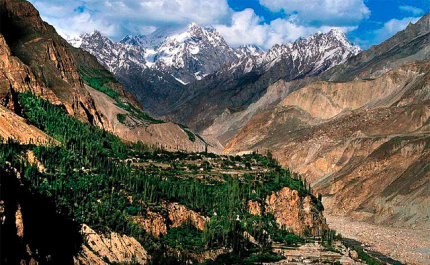Nearly half the world’s countries have significant mountainous regions. Mountain ecosystems provide more than half of the world’s population with water for domestic use, agriculture, industry and power generation. Mountains are home to half of the world’s biodiversity hotspots and many threatened and endangered species. Mountain regions are among the most sensitive to climate change, and receding glaciers are one of the most visible indicators of that change.
Still, there is no strong international body to express the problems of the millions of people who live in mountain regions around the world. The Mountain Partnership (MP) was formed as a relatively informal group to fill this gap. The membership of this Rome-headquartered group has now grown to over 200 government, inter-governmental and civil society organisations. It held its fourth global meeting in Erzurum, Turkey at the end of September. Over 100 participants from over 30 mountain nations were present.
Thomas Hofer, interim coordinator of the MP Secretariat, said this was a critical time for reflection and re-orientation of the future of partnership for knowledge sharing and networking for sustainable mountain development. Essentially, this implies improved natural resources management leading to improvements in livelihoods of mountain communities, he said.
Hofer highlighted the need for advocacy, joint action, knowledge management and communication, capacity building and technology transfer, innovation and resource mobilisation. The idea is to ensure that mountains get the attention they deserve in international negotiations, particularly the Sustainable Development Goals process of the United Nations.
Specifically, the participants – which included civil society organisations from the Hindu Kush Himalayan region – decided that they would push for
- promoting erosion control;
- incentivizing resource conservation;
- promoting alternative livelihoods;
- creating protected areas to save wild genetic material;
- developing early- warning systems and disaster-response teams for hazardous areas;
- identifying mountain areas threatened by air pollution; and
- creating information centres on mountain ecosystems to build expertise on sustainable agriculture and conservation areas.
The Mountain Partnership has done strong advocacy work in the past to advance a global green agenda. Following its earlier summit in Kathmandu in 2011, it called for
- the establishment of mechanisms to compensate and reward communities for mountain ecosystem services and improvement in markets for these services;
- creation of an enabling environment for promoting the green economy and investment in mountain regions;
- the ecosystem-based management approach; and
- efforts to ensure access and rights for women and indigenous communities, including valuation and utilization of traditional knowledge and practices.
At this year’s summit in Turkey, there was much talk about the need to share scientific data on what is happening to mountain ecosystems, an agenda backed strongly by the well-known academic, Bruno Messerli of the University of Bern.
Bringing in the developing country perspective, Sam Kanyamibwa of the Albertine Rift Conservation Society in Rwanda emphasised the need to reconcile conservation with development in mountain countries. He reviewed the various ecosystem services provided by montane forests, including erosion and flood control, climate regulation, food production and pollination. He stressed that communities deserve to benefit “sustainably and significantly” from these ecosystem services. He noted that climate change poses significant challenges to mountain ecosystems, from glacial melt to projected losses in species richness, and urged intensification of efforts to help mountain communities adapt.
Kanyamibwa called for an integrated approach to mountain sustainability that considers economic prosperity, social well-being and environmental impacts.
The problems are severe, and widespread. As glaciers recede under the impact of global warming, lakes forming at their snouts in Pakistan’s Bagrote valley (Gilgit-Baltistan) are bursting their banks and causing flash floods downstream, said representatives of Pakistan Mountain Areas Conservation and Development Services.
Discussing various ways to tackle such problems, Kashinath Vajpai from Climate Himalaya in India talked about the need to bridge the knowledge gap around climate change in the Himalayan region. The need, he said, was to develop an empirical climate network that aims to close this gap through knowledge sharing and networking.
Eklabya Sharma – representing the premier research organisation in the Himalayan region ICIMOD (International Centre for Integrated Mountain Development) – highlighted the dramatic impacts of climate change in the Himalayas, including thinning of the ice mass and glacial shrinking. He noted that it was difficult to assess the exact volume of loss.
Talking about the social impacts of such changes, Sharma said it had resulted in “gendered migration” in the Himalayas, with men leaving to seek opportunities elsewhere, leaving women and children behind.
Anita Paul and Kalyan Paul work for the Pan Himalayan Grassroots Development Foundation, based in Uttarakhand, India
